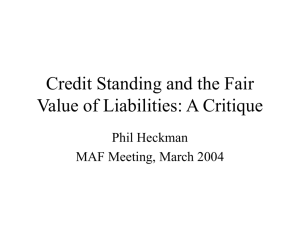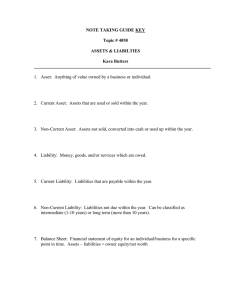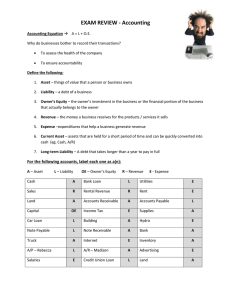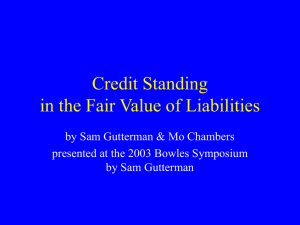Credit Standing and the Fair Value of Liabilities: A Critique Phil Heckman
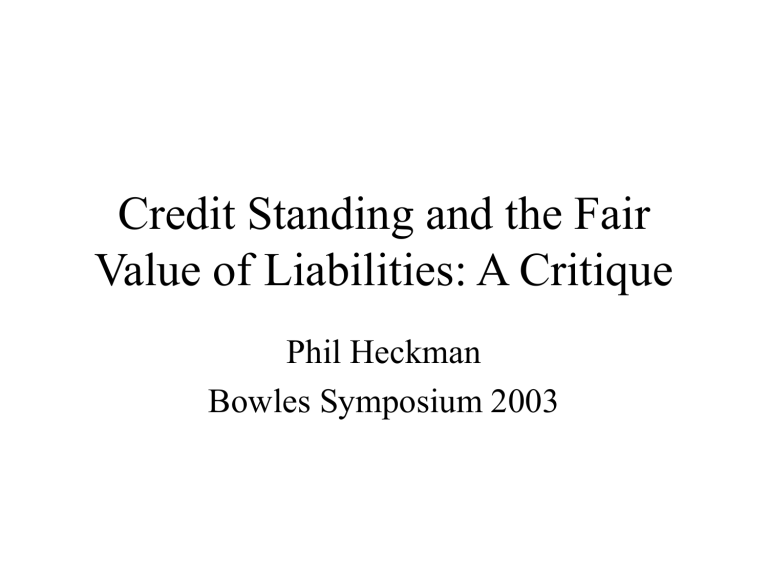
Credit Standing and the Fair
Value of Liabilities: A Critique
Phil Heckman
Bowles Symposium 2003
Whether the fair value of a liability should be independent of the debtor’s credit standing.
Why won’t this question go away?
Why Fair Value?
• Keeping valuation close to market ensures access to markets without big adjustments.
• Fair value of an asset is what it will fetch or reasonable equivalent.
• What is the fair value of a liability?
IASB Definition
The fair value of a liability is the amount required to induce an independent, knowledgeable third party to take over the liability in an arm’s length transaction.
Note that the credit standing of the third party is unspecified.
FASB Position
• Third party has “comparable credit standing”.
• Hence liability is discounted for credit risk.
• Why? (Not because it’s correct)
• Because that’s how debt is treated under current GAAP.
FASB Reference
Crooch, M.G., and Upton W.S.,
2001, “Credit Standing and
Liability Measurement” in
Understanding the Issues 4(1),
Financial Accounting Standards
Board, June 2001.
[Indispensable]
FASB Axioms
1. No gain or loss from borrowing.
2. Economic equivalence ==>
Accounting equivalence.
Are these mutually consistent? We shall see.
FASB Example (Same Date)
Comp Rating Rate Cash Term Principal
A AA 7% $5,083 10 yr $10,000
B
Risk
Free
B 12% $3,220 10 yr $10,000
5.8% $5,690 10 yr $10,000
FASB Fair Value Liabilities
• A and B undertake identical obligations.
• Per Axiom 1, A posts $5,083. B posts
$3,220.
• However, per Axiom 2, the liabilities should be the same. Inconsistency?
• B, the weaker of the two, has a steeper climb out of debt.
• B’s borrowing penalty is erased.
This practice has a name:
Handicapping
What is it doing in financial reporting?
Any guarantor looking at the two would insist on the same price for each.
Figure 1. Current GAAP: Good, Bad, Riskless
10,000
9,000
8,000
7,000
6,000
5,000
4,000
3,000
2,000
1,000
0
0 1 2 3 4 5
Years of Duration
6 7 8 9 10
A
B
RF
Figure 2. FASB Fair Value: B improves after 5 years
10,000
9,000
8,000
7,000
6,000
5,000
4,000
3,000
2,000
1,000
0
0 1 2 3 4 5
Years of Duration
6 7 8 9 10
A
B
RF
Figure 3. FASB Fair Value: B Downgraded at 5 yrs
10,000
9,000
8,000
7,000
6,000
5,000
4,000
3,000
2,000
1,000
0
0 1 2 3 4 5
Years of Duration
6 7 8 9 10
A
B
RF
10,000
9,000
8,000
7,000
6,000
5,000
4,000
3,000
2,000
1,000
0
0 1 2
Figure 4. FASB Fair Value: B has multiple downgrades
3 4 5
Years of Duration
6 7 8 9 10
A
B
RF
FASB Justification
• Balance sheet should show corporate owners’ interest, reflecting value of insolvency option.
• Reported net worth should never be negative; hence reflect credit standing.
This, too has a name:
Hogwash
AAA Monograph: Reason 1
A liability can extinguished by repurchase from the creditor at the current market price.
Therefore the fair value of the liability is the market price of the corresponding asset.
(Buyback argument)
Answer to Buyback Argument
The repurchase of a debt or other obligation is not an “arms length transaction”. The parties are already bound by contract in respect of the obligation. The definition of
“fair value” is violated, and the argument fails. If the obligation is laid off to a third party, the market value of the asset changes to reflect its credit standing .
AAA Monograph: Reason 2
If a company’s public debt is not valued at market (thus reflecting its own credit standing) it can manipulate its earnings by trading in its own debt. Therefore the fair valuation must reflect the company’s credit standing.
(arbitrage argument)
Answer to Arbitrage Argument
A company with the resources to trade in its own debt will have a credit standing that supports the price of its debt and erases the arbitrage advantage unless the trading is done surreptitiously. The implementation of
“fair value” should not be premised on commercial trickery. Therefore the arbitrage argument fails.
AAA Monograph: Reason 3
Per Reason 2, public debt must be valued at market (reflecting credit standing) to avoid arbitrage. There is no reason why other liabilities should be treated any differently.
Therefore all liability fair valuations should reflect credit standing.
(public debt argument)
Answer to Public Debt
Argument
The assertion is true, but the argument stands only if the premise is also true.
Based on prior argument, we reject the premise that any liability should be valued to reflect the debtor’s credit standing.
Therefore the true statement has no force, and the argument fails.
AAA Monograph: Reason 4
The usual mode of business ownership is through limited liability stock. The owner of such an asset is not liable should the corporation become insolvent. Therefore, to value the owners’ stake in the corporation, one must take credit standing into account in valuing the corporation’s liabilities.
(insolvency argument)
Answer to Insolvency Argument
This assumes that financial reports are private documents for the use of the owners. On the contrary, they are public documents for the use, e.g.
of potential investors. They should be independent of the mode of ownership.
The insolvency adjustment belongs on the ownership accounts as an asset windfall to balance asset penalties on the creditors’ accounts.
Liabilities are not affected.
Is this such a big deal?
Granting that liabilities reflecting credit standing are of no use, still the value of the insolvency option can be reported in a footnote somewhere and useful liability valuations recovered by those with the skill and knowledge to do so. Those without such skill need not be considered.
Yes it is a big deal!
However the correct value appears, the valuation requires an objective standard that does not yet exist. The creation of such a standard, and the role of regulators in enforcing it are the crucial issues.
How should it be done?
Objective Valuation Standards
• Fair value of liability = price of transfer to a risk-free third party.
• Modeled value depends only on contract and general economy.
• Fair value = Asset value + Price of a riskfree guarantee (Merton-Perold risk capital).
• Risk adjustment for uncertainty is always positive (decrease in discount rate).
Components of Liability Fair
Value
Fair value =
Market value of asset
+
Loading for Credit
Risk
+
Loading for Contract
Risk
45
40
35
30
25
20
15
10
5
0
Asset
Plus
Credit
Plus
Contract
Discussions of Risk Adjustment
• Casualty Actuarial Society, 2000, Task
Force on Fair Value Liabilities, White Paper on Fair Valuing Property/Casualty
Insurance Liabilities . ed. Blanchard.
• Butsic, R.P., 1988, “Determining the Proper
Interest Rate for Loss Reserve Discounting:
An Economic Approach”, CAS
Discussion
Paper Program ,
In Conclusion
• The notion of reflecting credit standing is not sound theory beset by practical problems; it is bad theory and ethically defective – unworthy of consideration.
• The probability that this will be put right is rather low, ~ 5%.
• The financial community must be prepared for a very rough ride.
Summary 1
The emperor has no clothes.
FASB’s position on fair value of liabilities is biased by a vested interest in current GAAP practice and could have ruinous consequences if put into practice.
Summary 2
The emperor has never had any clothes.
The GAAP treatment of debt has always been flawed, impeding valid comparison of different enterprises and biasing managements in favor of debt financing over equity.
Summary 3: Disclosure of
Ideological Bias
Antiprestidigitarianism
Can you say that?
Summary 4: What’s at Stake
Commerce
Brigandage

